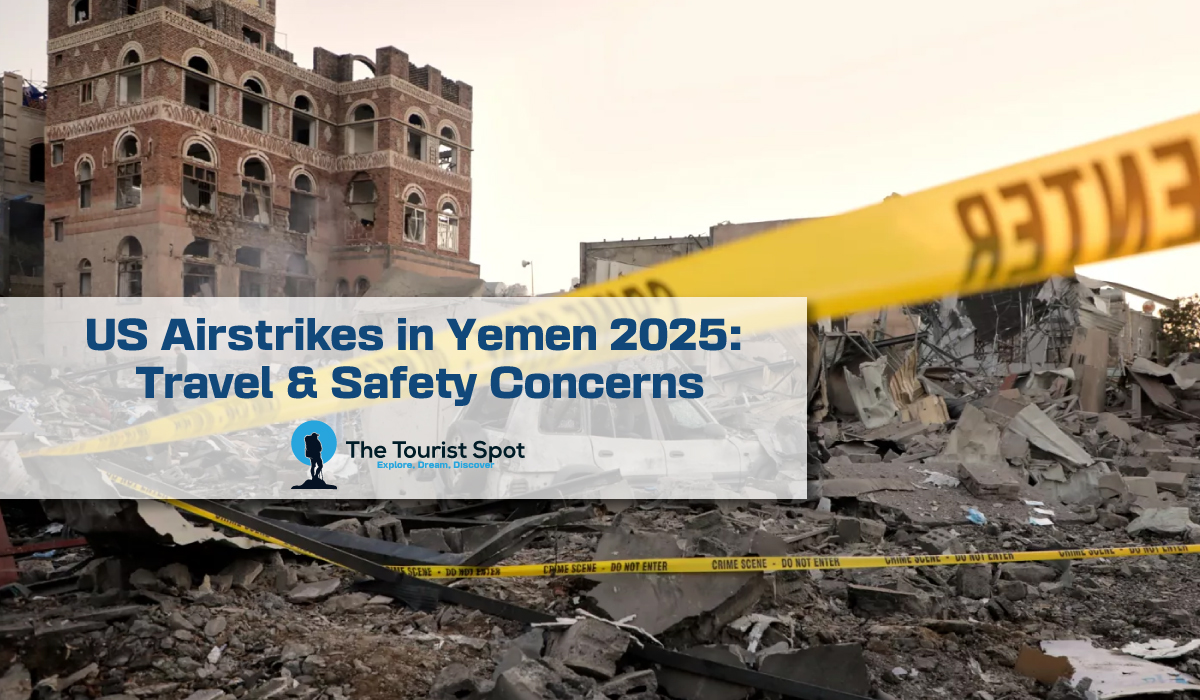In 2025, the geopolitical landscape of the Middle East has once again been shaken as US airstrikes in Yemen 2025 intensify. As the conflict escalates, concerns over civilian safety, political stability, and global travel advisories have surged. The impact is not limited to just military or diplomatic spheres—tourism, humanitarian aid efforts, and regional connectivity are all under pressure.
This article explores how the US airstrikes in Yemen 2025 are affecting travel and safety, what international travelers need to know, and why the region’s instability should not be underestimated.
Background of the Airstrikes
The airstrikes are part of the United States’ ongoing counterterrorism operations in Yemen, targeting militant groups suspected of threatening regional security. While these military actions aimed at neutralizing threats, they often have unintended consequences, especially for civilians and infrastructure.
The latest wave of strikes in early 2025 has resulted in increased tension across the Arabian Peninsula, drawing concern from international communities and prompting renewed debates about military involvement in Yemen.
Immediate Travel Advisories
As a result of the recent military escalation, the U.S. State Department and other foreign ministries have updated their travel advisories for Yemen. Most now strongly discourage any non-essential travel to the country. Yemen considered extremely high-risk due to:
- Ongoing armed conflict
- Terrorist activity and kidnappings
- Unstable government structures
- Limited or non-existent medical and emergency services
Airlines have canceled or suspended flights to key Yemeni airports, and many travel insurance companies have stopped providing coverage for trips to the country.
Safety Concerns for Travelers
The US airstrikes in Yemen 2025 have created a situation where travel is not just risky—it may be impossible. Even travelers with essential missions, such as journalists or aid workers, face severe challenges. Some of the top safety concerns include:
- Risk of being caught in crossfire or bombings
- Disruption of communication networks and transportation
- Lack of access to safe lodging, food, and healthcare
- Restrictions at border crossings and checkpoints
Travelers urged to avoid transit routes that pass near or through Yemen, even if the destination is another Middle Eastern country.
Impact on Regional Travel and Tourism
The effects of the Yemen conflict not contained within its borders. Neighboring countries like Oman, Saudi Arabia, and even parts of the United Arab Emirates are tightening border security and issuing cautionary notices.
Middle Eastern airlines may reroute flights to avoid Yemeni airspace, leading to longer travel times and increased airfare. Tourists heading to nearby Gulf destinations may find that the overall appeal of the region has diminished due to safety worries and media coverage of the conflict.
Humanitarian and Economic Effects
The travel sector is just one of many facing disruptions. Humanitarian efforts in Yemen have become even more dangerous. Aid convoys and NGOs have limited access to conflict-affected zones. Meanwhile, local economies are suffering from inflation, unemployment, and destruction of key infrastructure.
Yemen’s already fragile tourism sector—once known for its historic cities, ancient architecture, and coastal beauty—is now virtually non-existent. The escalation in 2025 expected to push the country further into economic distress and global isolation.
What This Means for International Travelers
If you’re considering travel to the Middle East in 2025, it’s essential to do your homework. While some countries in the region remain safe, instability in Yemen can spill over into neighboring territories. Here are some travel tips:
- Check government advisories regularly
- Register with your embassy when abroad
- Avoid border areas near conflict zones
- Monitor local news for updates on security developments
- Have an exit strategy or evacuation plan if you must be in the region
Being informed and prepared is the best way to stay safe in a rapidly changing environment.
Political Reactions and Future Outlook
Globally, the US airstrikes in Yemen 2025 have received mixed reactions. Some nations support the actions as necessary counterterrorism measures, while others express concern over sovereignty and civilian casualties. The United Nations has called for restraint and renewed diplomatic efforts to resolve the crisis peacefully.
If the conflict continues to escalate, it may lead to broader regional unrest, further impacting travel and trade. Analysts suggest that without a ceasefire or negotiations, Yemen could face prolonged isolation.
Conclusion
The US airstrikes in Yemen 2025 are a stark reminder of the volatility in certain parts of the world. While the aim is to stabilize the region by targeting threats, the consequences often extend far beyond military objectives. For international travelers, especially those with plans in the Middle East, understanding the situation and responding with caution is critical.
Safety must come first. Until peace and stability return to Yemen, travel to the country remains a serious risk—and one that should be avoided.

